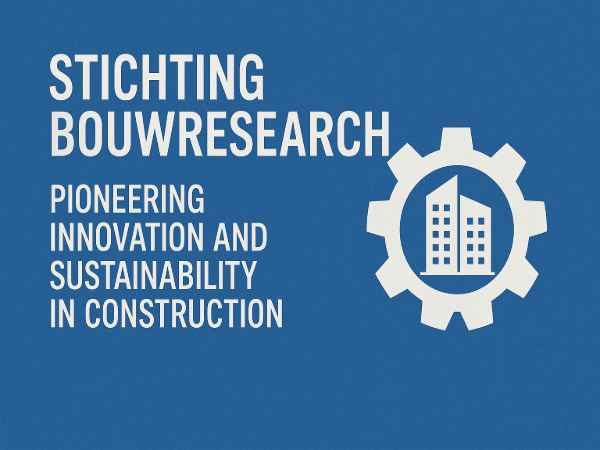Stichting Bouwresearch: Pioneering Innovation and Sustainability in Construction
How a Dutch Institution Transformed Global Building Practices Through Research, Technology, and Vision

Stichting Bouwresearch, also known as SBR, was one of the most influential research institutions in the Netherlands. Established in 1959, SBR played a pivotal role in shaping the modern construction landscape by driving innovation, promoting sustainability, and establishing new building standards. Through its extensive research, collaboration with industry professionals, and commitment to development, SBR set benchmarks that influenced construction practices not only in the Netherlands but also across the globe.
The Origins and Vision of Stichting Bouwresearch
Founded during the post-World War II reconstruction era, Stichting Bouwresearch emerged out of necessity. The Netherlands, like many European countries, was facing a massive housing shortage and deteriorating infrastructure. Policymakers and engineers needed a centralized institution that could lead scientific research into more efficient, cost-effective, and sustainable building practices.
SBR was created to be that hub. The institution’s founding vision was to integrate academic knowledge with real-world applications, providing architects, builders, and policymakers with tools and insights to enhance construction quality. By focusing on empirical research, data collection, and technical documentation, SBR quickly became the go-to authority on construction innovation in the country.
Mission and Objectives
The core mission of Stichting Bouwresearch was simple but profound: to advance the quality, sustainability, and efficiency of construction through research and knowledge dissemination. This included:
Developing construction techniques that reduced costs and time
Promoting energy efficiency and environmental responsibility
Establishing national guidelines and technical standards
Bridging gaps between academia, industry, and government agencies
Encouraging digital transformation through the adoption of new technologies
By pursuing these objectives, SBR ensured that the Dutch construction sector remained agile, competitive, and environmentally responsible.
Major Achievements and Contributions
Over its nearly six decades of operation, SBR contributed significantly to the construction sector. Some of its most notable achievements include:
Development of SBR Guidelines
SBR became particularly well-known for its “SBR-richtlijnen” or SBR guidelines, which addressed issues such as building vibrations, human disturbance, and equipment sensitivity. These guidelines became standard references in engineering and urban planning.
Promotion of Sustainable Building
Well ahead of global trends, SBR championed sustainable construction. It introduced life-cycle analysis tools, supported the development of energy-efficient building materials, and promoted eco-certifications such as FSC and PEFC.
Digitization and Smart Building Integration
SBR played a pivotal role in advancing Building Information Modeling (BIM) and other digital tools. It supported research into IoT, AI-based construction management, and digital twins, helping the industry transition into the age of smart construction.
Modular and Circular Construction
Years before circularity became a buzzword, SBR invested in modular design systems and reusability protocols. Its work on prefabrication, disassembly, and recyclable materials inspired a wave of innovation in urban development.
Collaboration with Industry and Academia
A defining feature of Stichting Bouwresearch was its ability to connect different stakeholders within the construction ecosystem. SBR worked closely with universities, technical institutes, construction companies, and government bodies. These collaborations allowed for faster adoption of research findings and a seamless transition from laboratory to real-world application.
Through joint ventures and pilot projects, SBR tested new materials, structural systems, and energy solutions in real-life settings. These partnerships not only validated theoretical models but also ensured that innovations were both practical and economically viable.
Influence on Policy and Regulation
Stichting Bouwresearch had a lasting impact on construction policy and building regulations in the Netherlands. The organization’s research often served as the scientific backbone for national building codes. Its guidelines on sustainability, structural integrity, and noise control were widely adopted by policymakers.
Moreover, SBR’s influence extended to European and global regulatory bodies. Many of its findings were incorporated into ISO standards and European Union directives on building performance and environmental impact.
Case Studies: Projects and Pilots
To understand the tangible impact of Stichting Bouwresearch, it’s essential to look at some of the landmark projects it supported:
Cantate Project
A breakthrough in acoustic optimization, this project utilized AI algorithms to model and improve sound performance in large indoor spaces.
Energy Leap Zutphen
A sustainable neighborhood development that implemented advanced thermal storage and heat pump technologies, setting a new standard for gas-free communities in the Netherlands.
Rotterdam Green Office
SBR’s research helped retrofit an existing office building to achieve a 40% reduction in energy use. This project demonstrated the feasibility of transforming old structures into green buildings.
Evolution: From SBR to SBRCURnet
In 2003, the organization rebranded as SBR to reflect its modernized focus. A decade later, in 2013, it merged with CUR (another construction knowledge institute) to form SBRCURnet. This merger was intended to streamline knowledge dissemination and consolidate expertise in both infrastructure and vertical construction.
Operating from Delft’s Bouwcampus, SBRCURnet continued the legacy of SBR until 2017, when it ceased independent operations due to funding shifts. However, its work did not disappear. Most of its activities were absorbed by two successor organizations: CROW (infrastructure focus) and ISSO (building services focus).
Lasting Legacy and Global Influence
Even though Stichting Bouwresearch no longer exists as a standalone entity, its legacy continues to shape the construction world. Its guidelines remain standard references in engineering courses, its research is cited in international journals, and its pilot projects continue to serve as models for sustainable development.
The ethos SBR established—of collaboration, innovation, and evidence-based practice—has become the gold standard in construction research globally. Countries looking to modernize their construction sectors often cite the Dutch model pioneered by SBR as a reference.
The Future: Continuing the Vision
While SBR as an institution is no longer active, its spirit lives on through the ongoing work of organizations like CROW and ISSO. These entities continue to expand on SBR’s foundational research, exploring areas such as:
Climate-adaptive building design
Integration of AI and robotics in construction
Circular material tracking and reuse
Urban resilience and disaster preparedness
Moreover, Dutch universities and private sector companies continue to build on SBR’s research to maintain the Netherlands’ leadership in sustainable construction.
Conclusion
Stichting Bouwresearch stands as a testament to what can be achieved when science, industry, and policy align toward a common goal. Its commitment to quality, sustainability, and innovation transformed not only the Dutch construction sector but also set a benchmark that many countries continue to follow.
Through its research, guidelines, and collaborative projects, SBR left an indelible mark on the global construction industry. Even in its absence, the organization’s legacy continues to guide current and future generations of engineers, architects, and builders toward a smarter, greener, and more resilient built environment.



